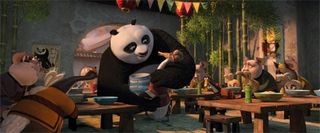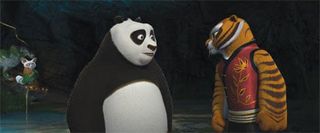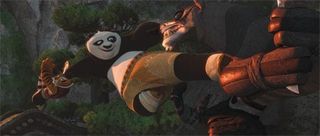Skadoosh! More From Our Exclusive Interview With Kung Fu Panda 2 Writers

Time for part two, everybody! Earlier today I posted the first half of my interview with Kung Fu Panda 2 writers Jonathan Aibel and Glenn Berger. During that part of the interview (which you can see right HERE) we talked about long-term planning in franchises, inspiration and choosing a peacock as the film’s main villain. But there’s so much more to talk about!
In this half of the interview, Berger and Aibel discuss how working relationship, the contrast in working in animation vs. live action and their next project. After you finish reading, be sure to check out my review of Kung Fu Panda 2, as well as my analysis of the movie’s 3D. If you couldn’t already tell, I really loved this movie. Skadoosh!
So would you say that you write these stories for adults and then the kids find the humor?
Glenn Berger: I think you could say in terms of story, we’re not talking about individual jokes because I think it’s fair to say that there are some jokes that we know are going to play to parents and not to kids, and there’s some jokes that we know kids are going to like more than parents, but some grownups will like them as well. Aside from that, from the story point of view, we aim to tell, there’s a delicate balance, we aim to tell a sophisticated story full of intellectual satisfaction and emotional depth that is told clearly enough that kids will get it. And maybe kids are not getting every single nuance, but it was really gratifying to, my kids didn’t know too much about the story going in on purpose, I wanted to see what their reaction would be, they got it. They got every element of the story, they even got more of the opening sequence where it describes the back story of the peacock, which I worried would be entirely lost on them because it’s not told in CG, it’s told over narration and they totally got it, totally understood how it fit in with the rest of that movie, and that was really gratifying because for years we struggled, all of us on the team, struggled with the fear that the story is too complicated. And it was nice to see that it is complex, but ultimately, I think, understandable.
I’m curious about the working relationship between the two of you. When you’re developing a script, what is your process? Do you kind of each take sections, do you always work together?
Jonathan Aibel: I’d say mostly we always work together. We break everything together. We argue everything, discuss everything, write line for line together. In the middle there’s usually a time where, if we know, if we have an outline or a beat sheet, it’s okay you take that scene I’ll take this scene and just crap something out, just so you’re not saying okay, this scene, interior Lord Shen’s palace. Just so you’ve got something so you can convince yourself, “We have something, we’re just rewriting it. We’re not starting from scratch.” But aside from that, we’ve found in the years that we’ve been working together, it’s easier for us, well not easier, it’s better for the output if we go over every line and we write together.

In terms of your organization and planning, when it comes to some outline, do you have the entire storyline established before you start getting into the details?
CINEMABLEND NEWSLETTER
Your Daily Blend of Entertainment News
GB: You have to, because especially on these movies, so many other people are involved that by the time, we were not going off and writing until a very detailed storyline had been discussed and approved and tons of people had input. We started with one-liners of what could be the next proposed journey, and basically were posing questions. We said what, given everything, what could possibly be the conflict of the second movie? What could possibly be wrong with Po aside from who the villain could be, what’s internally an issue with Po? And once we found some nice juicy questions that everyone agreed would justify ninety minutes worth of exploration, then the challenge was for us to go off and say, now turn that into a three act structure. So then we did that and we’d come back and pitch it to people giving input. That happened over the course of maybe six months. Because we started without being too confident. We were not over confident about the success of the first movie, we started a little before the release of the first movie because our role as writers ends probably six months before the release of a movie, while everyone else, the directors and animators are in the busiest phase the final six months, the crunch to finish the movie. So we had the free time that other people didn’t, and we were kind of off dreaming up what the second movie could be about, and then six months after the release we finally got an approval on an outline and then started writing in earnest.
JA: The difference also is in animation, if you’re off writing a script, your role is not to say, “Oh, I’ve got a great idea for a new set or a new set piece.” Because they may not have that set or that set piece. Because the movie, when we’re writing, the movies often actually in production and parts are being made as we’re writing other parts of it. In our other work, not in our animated features, there’s a lot of, we may have an outline that’s pretty well beat up, but then you’re into a scene and you’re realizing, well, what you could say in an outline when you’re trying to figure out a character’s point of view, and you put yourself in the character’s shoes, maybe he’d have a different point of view, and then that starts affecting it. And then we found that if you beat out a story too much before you start writing, you don’t have any fun in the writing because you feel like, “Now I’m just doing that thing again that I’ve already done.” And the writing should be the fun part where you’re discovering stuff. So we like to keep our outlines a little looser so that we can find stuff in the writing.

I was also wondering, you kind of mentioned contrasting live action versus animation. Because when you’re doing animation, obviously you’re starting from scratch and you kind of have the freedom to do anything you want in the world. Do you feel restrictions in the animation world?
GB: In the animation world, the restrictions we feel are distinct to the world of the characters we’ve created. Having done the first movie for instance, the second movie is not going to have pop culture references or human characters and stuff like that. But the amazing thing about doing a sequel is the technology has gotten even better, so now stuff that would have been cost prohibitive in the first movie is all over the second movie. I remember in the first movie, when we were first being schooled in the world of feature animation, water was one of the most expensive things you could do was get a character’s fur wet. And now you’ll see in the second movie there’s water everywhere. So many people are wet. That’s something, even when we were talking about the third act set piece, people are batting around ideas. The initial concern was, can you do that? Can you set a bunch of act three in water? And the answer turned out to be yes you can, because the rendering technology has gotten faster and less expensive.
JA: There still is a belief that, “Oh in animation you can do anything,” but at the end of the day, if you create a character, someone has to design it, someone has to rig it, meaning build the skeleton with it in it, and those things take time and they take money, so you can’t just say, “Let’s do the world is our oyster, let’s do whatever we want.” There’s still a reality of money and time and man-hours or woman-hours, person hours, to do this stuff and there’s still need to have complexity meetings where they will look at a scene and say what’s the effect? How many effects are there? What are the costumes? Do people need new outfits? Less so in the movie, but do people need new hairstyles? All those things actually cost money and take time so in a live action movie in some ways there are fewer restrictions because in a sense, you don’t have to worry about those things. You can put someone in a new costume pretty easily.
GB: To answer your other question about the biggest difference, to us the biggest difference in our work between live action and animation is that in live action, we develop a script, we’re rewrite a script, but when the movie goes into production, for better or for worse, we may visit the set but we’re not really involved to the extent that an animated movie is effectively in production for its entire three years or four years, depending on the movie. We’re writing, we’re going to editing, we’re going to voice recording sessions, and we’re re-writing based on what we’ve seen. It’s both more grueling and more creatively satisfying because we’re so intimately involved in the process from beginning to end, that’s been great.

What are you guys working on now?
JA: We are in the throes of writing Candyland for Universal, Kevin Lima to direct, which we’re attempting to do what Kung Fu Panda does, which is to take a title that everyone rolls their eyes at and says, “Oh, how’s that gonna be a good movie?” and actually make it a good movie. And I think Candyland has that, we’re not aware that when it was announced people said, “Oh no, Hollywood does it again! What’s next? Another movie based on a board game.” Which to us is the great challenge of it, how do you take what really is a board game with no strategy and not much to do and say, but that can make a really exciting movie if you take just elements of it and inject it with a seriousness, that you imagine if a family brought into a world that just happens to be made of candy where there are Shakespearean elements at play, that sounds just like something awesome that we’d like to see.
Is that being developed as CG animation?
JA: I think it would be live action with CG elements. Actors and then the world, I guess what Alice in Wonderland was, in a sense.
How far along are you guys with it?
JA: We are in the scriptwriting.
GB: I’ve been writing the whole time.
What about Kung Fu Panda 3? I guess at the end, I don’t want to give anything away, but the end kind of does suggest...
JA: It does, in such a way that I think the third, if there is one, should do something completely opposite, so everyone says, “What was that?” We’d love to make another, I feel like there’s more stories to tell with Po, and I guess at this point we just hope that everyone else wants to see one. It’s hard to be overconfident in this day and age where we think people will like this movie and not turn on it for being a sequel, but we’ll just wait and see.

Eric Eisenberg is the Assistant Managing Editor at CinemaBlend. After graduating Boston University and earning a bachelor’s degree in journalism, he took a part-time job as a staff writer for CinemaBlend, and after six months was offered the opportunity to move to Los Angeles and take on a newly created West Coast Editor position. Over a decade later, he's continuing to advance his interests and expertise. In addition to conducting filmmaker interviews and contributing to the news and feature content of the site, Eric also oversees the Movie Reviews section, writes the the weekend box office report (published Sundays), and is the site's resident Stephen King expert. He has two King-related columns.
Most Popular





